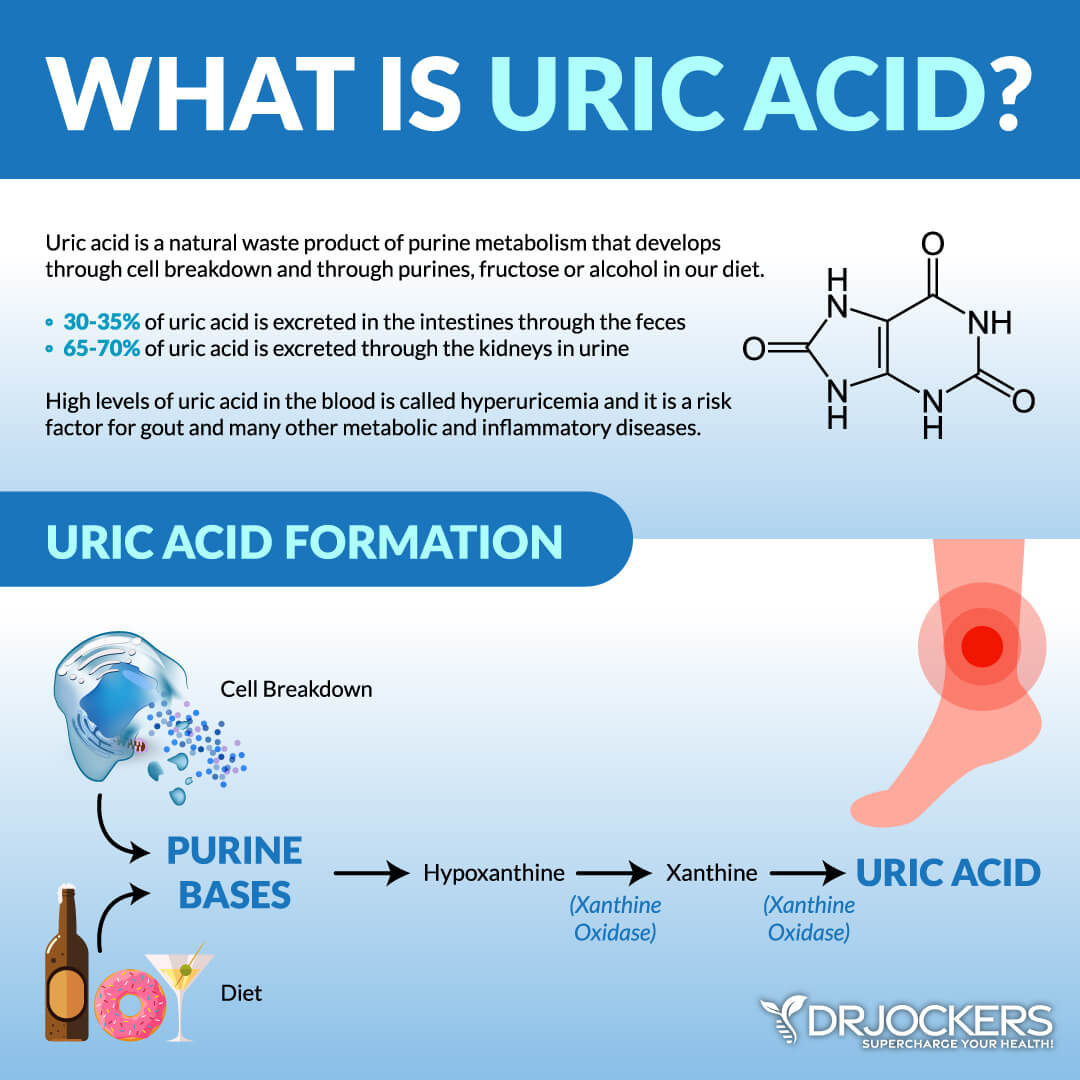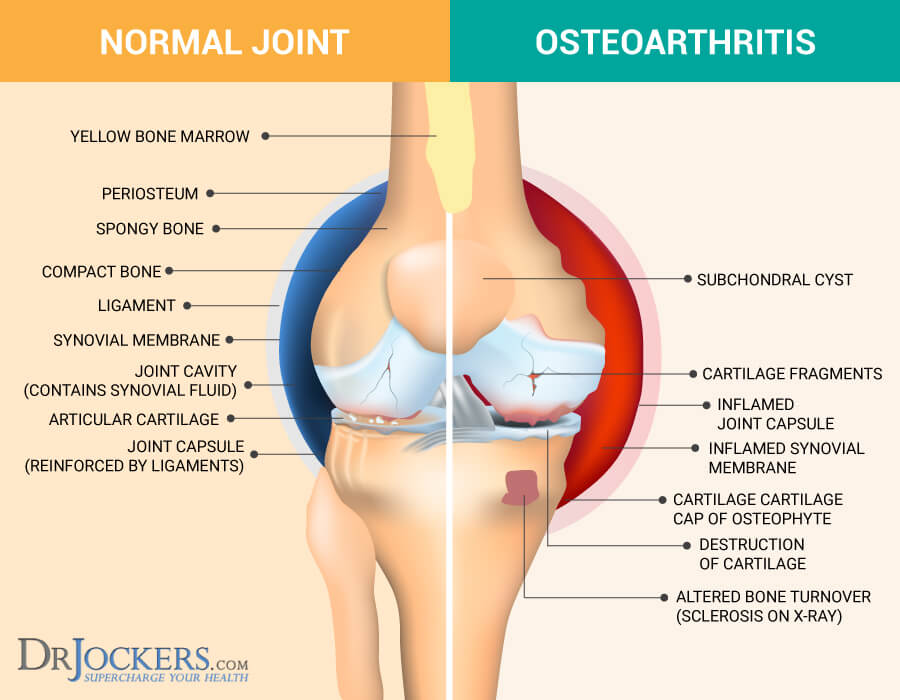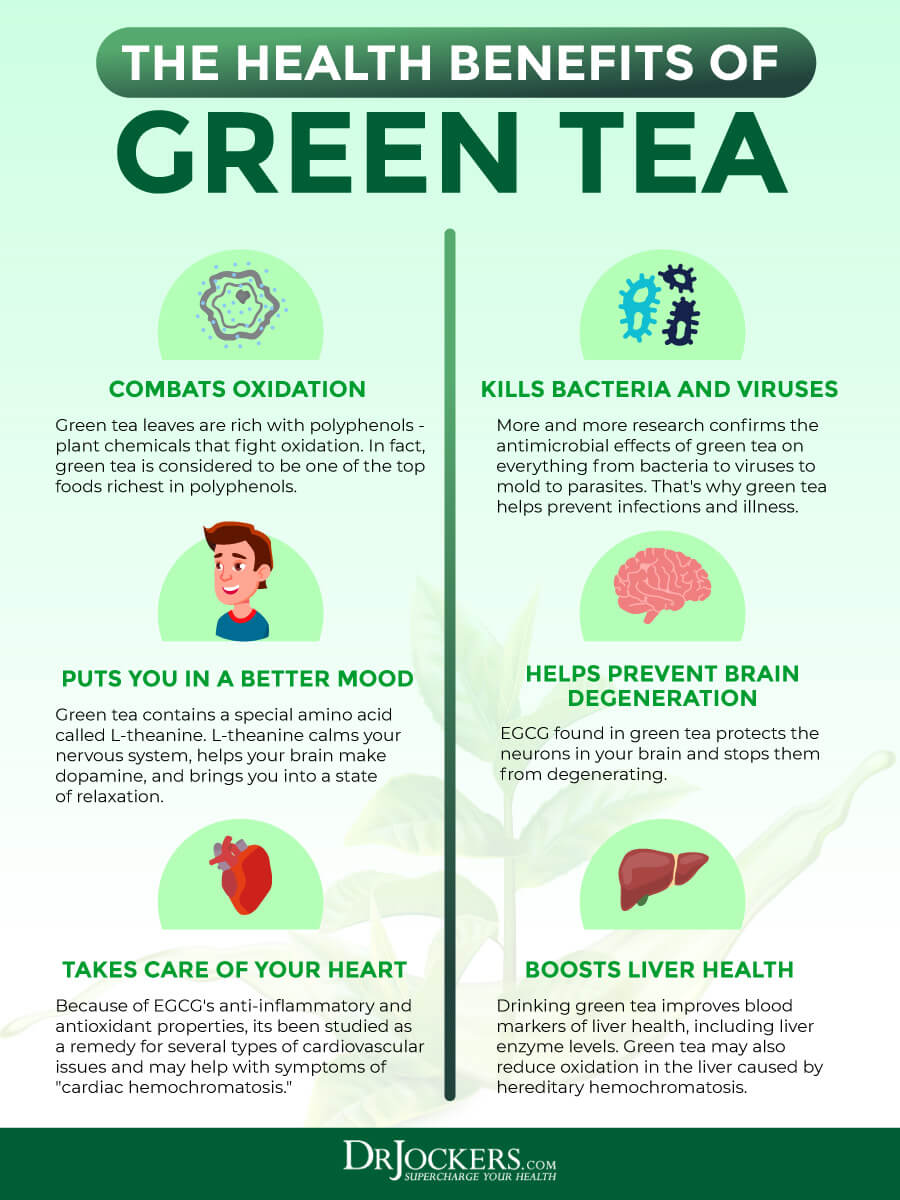 Uric Acid: A Key Player in Cardio, Brain, and Metabolic Diseases
Uric Acid: A Key Player in Cardio, Brain, and Metabolic Diseases
Uric acid is a natural waste product in your blood that helps to break down purines. Once uric acid dissolves in your blood, it moves through your kidneys that leaves your body through urine. However, if your body cannot remove all excess uric acid, it can lead to a build-up causing high uric acid levels called hyperuricemia. High uric acid levels may lead to kidney stones, gout, and other health issues. The good news is that it’s possible to reduce your uric acid levels with the help of some natural support strategies.
In this article, you will learn what uric acid is. You will learn about the connection between fructose and hyperuricemia. You will learn about the connection between purines and uric acid. I will discuss the top health conditions associated with high uric acid. I will explain how testing works for uric acid levels.
I will go over the benefits of a Comprehensive Blood Analysis. You will learn about how genetic polymorphism may be associated with high uric acid. Finally, I will offer some natural support strategies to reduce high uric acid levels.

What Is Uric Acid
Uric acid is a natural waste product in your blood. It is a chemical made by your body to break down purines. Purines are chemicals created in your body. They are also found in certain foods and drinks.
In a healthy body, most uric acid will dissolve in your blood, move through your kidneys, and get removed through the urine. Food high in uric acid and certain health issues, including diabetes, high blood pressure, and fatty liver disease, however, may lead to too much uric acid staying in your body.
Hyperuricemia is a condition that refers to too much uric acid remaining in the body. It may lead to crystals formation, causing gout when settling in your joints or kidney stones when settling in your kidneys. If left untreated, high uric acid levels may cause kidney damage, bone and joint issues, tissue damage, or heart disease.

Fructose and Uric Acid
Fructose is a monosaccharide, which is a type of sugar. Because fructose mainly occurs in fruits, it is often referred to as fruit sugar. Honey, sugar cane, sugar beet, and many vegetables also contain fructose.
When your body breaks down fructose, it releases purines. To break down purines, your body releases uric acid. If you consume too much fructose, it will lead to increased purine and then uric acid release. Your body may not be able to keep up, which may cause high uric acid levels. Research suggests that there may be a connection between fructose and uric acid.
A 2011 review published in Seminars in Nephrology has found that there are increased issues with hyperuricemia associated with the consumption of fructose and sweetened drinks (1). A 2017 review published in Nutrients has also found that high fructose intake may increase uric acid levels and associated risk of cardiometabolic disorders (2). A 2020 review published in Biomedicine & Pharmacotherapy has also found that increased fructose may increase the risk of hyperuricemia (3).

Purines and Uric Acid
Your body produces uric acid to break down purines. Purines are created when breaking down fructose. They are also found in many foods and drinks. Foods higher in uric acid include salmon, shrimp, sardines, lobsters, mackerel, anchovies and some other seafood, red meat, liver and other organ meats, dried beans, peas, alcohol, and food and drinks made with high fructose corn syrup.
If you eat too many foods high in purines, it may lead to increased uric acid production and uric acid build-up. Thus eating too many foods high in purines may lead to health issues. A 2012 study published in Annals of the Rheumatic Diseases has found that eating foods high in purine may lead to recurrent gout attacks (4).
A 2012 cross-sectional study published in PLoS One has found that vegetables high in purine may increase uric acid levels (5). Reducing the intake of purine-rich vegetables, however, may help to lower uric acid levels.

Top Conditions Associated with High Uric Acid
Untreated high uric acid can lead to serious health consequences. Here is a list of the top health conditions associated with high uric acid levels.
Gout
Gout is a type of inflammatory arthritis characterized by pain, tenderness, swelling, and redness that comes in sudden and severe attacks (6). It can affect one or more joints and usually occurs in the big toe. Gout is generally caused by hyperuricemia or high uric acid levels that can build up in your joints.
A 2016 study published in Postgraduate Medicine has found that targeting serum uric acid is important for the treatment of gout (7). According to a 2017 review published in the Journal of Advanced Research, diet and lifestyle changes may be an important part of targeting uric acid levels in gout (8). It’s important to note that though gout is caused by high uric acid levels, hyperuricemia doesn’t always result in gout (6).

Diabetes
In type 2 diabetes, your body is unable to regulate and use glucose (sugar) as fuel as it should. Over time this will lead to too much glucose circulating in your bloodstream causing high blood sugar levels and blood sugar fluctuations. Long-term, this may lead to the immune, nervous system, and circulatory health issues.
High uric acid may increase the risk of insulin resistance which may increase the risk of prediabetes and type 2 diabetes. Women are at higher risk than men. A 2016 cohort study published in the Annals of Rheumatic Disease, has found that women with gout are 71 percent at a higher risk of developing type 2 diabetes, while men only have a 22 percent increased risk (9).
However, it’s not only high uric acid and gout that increase the risk of type 2 diabetes, but type 2 diabetes may also increase the risk of high uric acid and gout. People with type 2 diabetes are often overweight or obese and carry extra fat around their belly area.
This may interfere with healthy kidney function, which may also reduce your body’s ability to remove uric acid as fast and as effectively as it should. According to a 2020 population-based cohort study published in the Annals of Internal Medicine, type 2 diabetes patients who were prescribed sodium-glucose transport protein 2 (SGLT2) inhibitors, a diabetes medication, had a lower risk of developing high uric acid and gout than those who were not (10).

Fatty Liver Disease
Fatty liver disease means that there is too much fat stored in your liver cells. Nonalcoholic fatty liver disease (NAFLD) refers to a group of liver conditions that are characterized by a fatty liver and affects people who only drink little to no alcohol. Fatty liver disease can cause liver inflammation, cirrhosis (advanced scarring of the liver), and liver failure.
Fatty liver disease is often associated with high uric acid levels. According to a 2019 study published in Medicina (Kaunas), high uric acid levels are linked to non-alcoholic fatty liver disease (11).
The study has found that hyperuricemia in non-alcoholic fatty liver disease are a common issue and they are more common in non-obese and younger patients with non-alcoholic fatty liver disease. A 2017 study published in Lipids in Health and Disease has found that high uric acid levels are a problem in non-obese adults with non-alcoholic fatty liver disease (12).

Hypertension
Hypertension or high blood pressure means that the long-term force of the blood against your artery walls is too high. High blood pressure is 140/90 or higher. Hypertension may increase the risk of heart disease, stroke, and mortality. High blood pressure is also associated with high uric acid.
According to a 2019 study published in Medicina (Kaunas), high uric acid levels are linked to hypertension (11). A 2010 review published in the Current Rheumatology Report has found that hyperuricemia may increase the risk of hypertension (12).
A 2003 review published in Hypertension has found that the connection between high uric acid levels and hypertension may lie in reduced renal blood flow (14). Researchers found that reducing uric acid levels may reduce the risk of hypertension. A 2020 review published in Hypertension Research has explained that hyperuricemia may cause endothelial damage and dysfunction which may lead to hypertension (15).

Cognitive Decline
Cognitive decline can range anywhere from mild forgetfulness and other signs of mild cognitive impairment to dementia. Dementia is a more severe cognitive decline that can seriously impact one’s life.
One form of dementia is Alzheimer’s disease. Signs of cognitive decline may include forgetting dates, appointments, events, or recent conversations, losing a sense of direction, having trouble organizing tasks, having difficulties following directions or instructions, and feeling overwhelmed by plans or decisions.
Cognitive decline may also be linked to high uric acid levels. A 2018 review published in Nutrients has found that uric acid levels may play a role in modulating cognitive function and hyperuricemia may play a role in the increased progression of dementia, Alzheimer’s disease, and Parkinson’s disease (16). A 2020 study published in Frontiers in Aging Neuroscience has found that hyperuricemia are linked to cerebral hypometabolism in Alzheimer’s disease (17).

Kidney Disease
Your kidneys are a pair of organs shaped like beans that filter your blood to remove any waste and extra water. If you have kidney disease, it means that your kidneys are damaged and unable to filter your blood effectively. Kidney disease may lead to kidney failure requiring dialysis or a kidney transplant.
As your kidneys filter your blood, excess uric acid may build up. This build-up can cause the formation of urate crystals which may scar and damage your kidneys. Ongoing kidney damage from uric acid buildup can lead to kidney disease.
A 2011 review published in Seminars in Nephrology has found a link between high uric acid levels and chronic kidney disease (18). A 2015 review published in Disease Markers has found that uric acid may be a potential marker for kidney disease and renal failure (19).

Osteoarthritis
Osteoarthritis is a type of arthritis. It is the most common form worldwide and your risk increases with age. Osteoarthritis most commonly affects your knees, hips, hands, or spine, but it can affect just about any joint in your body. Osteoarthritis may also be linked to high uric acid levels.
A 2011 study published by Duke University Medical Center has found that high uric acid levels can increase the risk of osteoarthritis (20). They found that high uric acid levels may increase the risk even in those without gout. A 2017 review published in Frontiers in Medicine (Lausanne) has found that gout and high uric acid levels may increase the risk of osteoarthritis (21).

Osteoporosis
Osteoporosis is a condition that weakens and thins your bones. As a result, they become more fragile and can fracture or break more easily. Osteoporosis most often affects the hips, wrist, and spine. The risk of osteoporosis may increase with age and is more likely to affect post-menopausal women.
Osteoporosis is often connected to high uric acid levels. A 2018 review published in Acta Pharmacologica Sinica has found that high uric acid levels are associated with osteoporosis and related fractures in post-menopausal females (23). A 2019 review published in Nutrients has found that high uric acid may inhibit vitamin D production, increase inflammatory cytokines and free radicals, and may reduce bone density and increase the risk of osteoporosis and bone fractures (24).

PCOS
Polycystic ovarian syndrome (PCOS) is a hormonal disorder that affects women of reproductive age. It may be characterized by excess androgen levels, prolonger periods or infrequent periods as the ovaries may fail to release eggs regularly or release more eggs than normal.
Symptoms beyond prolonged or missed periods may include cysts on the ovaries, weight gain, oily skin, acne, excess body hair, dark skin patches around the armpit, neck, or under the breast, and infertility. High uric acid in women is one of the risk factors for developing PCOS.
A 2018 study published in Reproductive Biology and Endocrinology has found that at 25.48 percent of women with PCOS had hyperuricemia compared to only 8.74% of those women without PCOS (25).
A 2021 study published in Reproductive Biology and Endocrinology has found that hyperuricemia can increase the risk of female reproductive disorders, including PCOS and endometriosis (26). They found that high uric acid may also lead to pregnancy complications.

Testing Uric Acid Levels
Checking your uric acid levels is critical, especially if you are dealing with symptoms of the above-mentioned health issues linked to high uric acid. The normal clinical range for uric acid that most doctors recommend is between 2.6 and 7.6 mg/dL. The functional range that us, functional medicine doctors, prefer is between 3.0 5.5 mg/dL.
High uric acid is not good but you don’t want it to get too low either. Low uric acid levels can also be a problem. Under 3 mg/dL may be a sign of poor phase II liver sulfation processes. The goal of Phase 2 of liver detoxification is conjugation. This is when your body removes metabolites from Phase I through bile, urine, and stool to reduce oxidative stress.
The conjugation process involves 6 major metabolic pathways including methylation, sulfation, glucuronidation, glutathione conjugation, acetylation, and glycation. Low uric acid may be a sign of issues with sulfation and a potential molybdenum deficiency. You can learn more about liver function and Phase II liver sulfation in this article.

Comprehensive Blood Analysis
To look at your uric acid levels and kidney functions, and other important health markers I recommend using the Comprehensive Blood Analysis (CBA). It is a very detailed blood test that looks at all of these markers of inflammation and other health functions.
This test is more sophisticated than most conventional doctors run. It looks at everything that a CBC and CMP do and more. It examines all parameters for inflammation, blood sugar levels, insulin levels, immune system function, thyroid function, parathyroid hormone levels, mineral and electrolyte balance, zinc and copper ratio, vitamin A and D levels, folate and vitamin B12 levels, a complete metabolic panel, complete blood count, liver function, kidney function, urinary tract health, nutrient deficiencies, and more.
I recommend getting the Comprehensive Blood Analysis done regularly both as a preventative measure and to monitor your inflammation levels and progress if you are on a treatment plan. Remember, our team is always happy to help to understand your results and create a personalized treatment protocol to regain your health and well-being naturally.
Genetic Polymorphisms Associated with High Uric Acid
Genetic polymorphism refers to certain mutations in the genotype. It describes a simultaneous incidence of two or more discontinuous genotypes or alleles. Genetic polymorphism may also be associated with hyperuricemia. According to a 2007 study published in PLoS Genetics, the GLUT9 gene may be associated with high uric acid (27).
According to a 2018 study published in Scientific Reports, the ABCG2 gene may also be linked to high uric acid and gout (28). According to a 2008 study published in National Genetics, the ALC2A9 gene is also associated with high uric acid levels (29). Along with complete blood testing, you may also benefit from some genetic testing.
How to Reduce Uric Acid Levels
As you now understand, high uric acid levels have been linked to a long list of health issues. The good news is that you can reduce your uric acid levels with the help of some natural support strategies.
If you want to learn more about this topic and how to reduce uric acid levels I highly recommend reading Drop Acid: The Surprising New Science of Uric Acid. If you want to reduce your uric acid levels and improve your health, here are the natural support strategies I recommend:
Reduce Alcohol, Sugar, and Fructose Intake
Drinking too much alcohol and consuming food and drinks with too much sugar and fructose may increase the risk of high uric acid and related health issues (1, 2, 3). A 2010 review published in the JAMA has found that drinking beverages high in fructose may increase the risk of gout in females (30). A 2008 review published in BMJ has found that high fructose intake may increase the risk of high uric acid in men as well (31).
A 2013 review published in Diabetes has linked both fructose and table sugar to an increased risk of hyperuricemia, increased visceral fat, and diabetes (32). A 2014 study published in the American Journal of Medicine has found that too much alcohol may increase the risk of high uric acid and gout (33).
Lowering your intake of sugar, fructose, and alcohol may also reduce the risk of obesity, diabetes, and other health issues that are connected to high uric acid. I recommend reducing your alcohol intake to occasional moderate intake or removing alcohol completely. I also recommend reducing your intake of refined sugar and fructose which should only come from low-glycemic index fruits and vegetables.

Consider Lowering Purines
Eating foods high in purine may lead to high uric acid levels and recurrent gout attacks (4, 5). A 2012 study published in Nutrition, Metabolism, and Cardiovascular Disease has found that foods high in protein may increase the risk of hyperuricemia (34). A 2019 review published in Nutrients has found that a low-purine diet may help to reduce uric acid levels, gout, and cardiovascular risk factors (35).
If you struggle with high uric acid levels, I recommend lowering your intake of foods higher in purines such as salmon, shrimp, sardines, lobsters, mackerel, anchovies and some other seafood, red meat, liver and other organ meats, dried beans, peas, alcohol, and food and drinks made with high fructose corn syrup.
Instead, switch to a low-purine whole foods diet rich in greens, vegetables, sprouts, herbs, spices, fermented foods, healthy fats, such as avocados, coconut oil, pasture-raised butter and ghee, olives, and extra virgin olive oil, and low-purine protein sources, such as grass-fed eggs and poultry, cold-water fish, such as tuna, and nuts and seeds.

Practice Intermittent Fasting
Intermittent fasting is a type of eating. It cycles between a period of fasting and a period of eating within one day. The most common form of intermittent fasting includes 16 hours of fasting, including your overnight sleep and 8 hours reserved for your meals to meet your nutritional needs. Intermittent fasting may improve autophagy, insulin sensitivity, digestion, inflammation, and other factors of health. Intermittent fasting may also help to reduce uric acid levels.
A 2019 review published in Nutrients has found that fasting and calorie restriction along with a low-purine diet may help to reduce uric acid levels, gout, and cardiovascular risk factors (35). At first, uric acid levels will rise during fasting, but post-fasting, it will return to normal levels. A 2019 case study published in Cureus has found that uric acid levels reduced and returned to normal after the fasting period of short-term intermittent fasting (36).
A 2021 study published in Clinical Diabetes and Endocrinology has found that intermittent fasting may also improve insulin resistance and diabetes (37). This is important because insulin resistance and diabetes may contribute to high uric acid levels and this may increase the risk of insulin resistance and diabetes. (9, 10).
If you are new to intermittent fasting, begin with a 12-hour fast including your overnight sleep starting after dinner until the next day at breakfast. Gradually increase your fasting window by delaying breakfast and/or choosing an earlier dinner.
Most people feel the best with the 16:8 approach but you may find that fasting for a bit less or longer than 16 hours works better for you. To learn more about the benefits of intermittent fasting and the best intermittent fasting strategies, I recommend this article.

Regular Exercise
Regular movement and exercise may also help to reduce your uric acid levels. According to a 2015 study published in the Annals of the Rheumatic Diseases, an inactive lifestyle may be linked to high uric acid levels, however, being active helped to decrease uric acid levels and mortality (38). A 2021 study published in Frontiers in Endocrinology (Lausanne) has found that moderate exercise offers the optimal benefits for reducing uric acid levels compared to low-level exercise or no exercise at all (39).
A 2015 study published in the American Journal of Lifestyle Medicine has found that the combination of exercise, limiting calorie intake, and weight loss may contribute to improved uric acid levels (40). However, they found that strenuous exercise and over exercising and undereating causing ‘starvation’ can actually increase uric acid and trigger gout.
Instead of over-exercising and under-eating, aim for long-term sustainable changes with regular moderate exercise and daily movement combined with a healthy diet and other healthy lifestyle choices. I recommend moving your body daily by getting up from your desk to stretch, taking a stroll in the park, biking or walking instead of driving, or playing with your pets and kids.
I recommend at least 20 to 30 minutes of moderate exercise five times a week combining strength-, resistance-, and cardiovascular exercise. Hiking, biking, swimming, and rebounding are great ways to get some cardio in. Weight lifting with free weights and weight machines, resistance band exercises, kettlebell workouts, and bodyweight exercises are great for resistance and strength training. Pilates and yoga are low-impact ways to build some strength and tone your body.

Good Hydration
Healthy kidney function is critical for removing excess uric acid from your body (18, 19). Good hydration can support kidney function and may improve uric acid levels. According to a 2015 review published in the American Journal of Lifestyle Medicine, exercise-related heavy sweating may increase uric acid and rehydration is critical to reducing uric acid levels (41).
A 2016 study published in BMJ Open has found that heart stress may decrease kidney function and increase uric acid levels making hydration important for reducing uric acid and improving kidney function (42). A 2017 meeting abstract from the American College of Rheumatology Annual Meeting has also found that good hydration may help to reduce uric acid and the risk of gout (43).
I recommend starting your day with a 16 to 32 oz. glass of water. Drink water throughout the day, about 8 oz. every hour. If you don’t enjoy the taste of water, you may add some lemon juice or add some cucumber or other veggie slices for flavor. I also recommend trying hydrogen water, you can learn about its benefits here. Eating hydrating vegetables, such as cucumber, celery, and romaine lettuce, eating soup, and drinking bone broth, herbal tea, green juices, green smoothies, or protein shakes can add extra hydration.

Optimize Vitamin D Levels
Vitamin D is an essential vitamin for your bone, muscle, immune, brain, and overall health. Improving your vitamin D may help to reduce uric acid levels. A 2020 study published in Frontiers in Nutrition has found a link between vitamin D levels and hyperuricemia (44).
Researchers found that low vitamin D levels may be associated with high uric acid and vitamin D supplementation may help to improve uric acid levels. A 2021 study published in the Journal of Clinical & Translational Endocrinology has found that vitamin D supplementation may be beneficial for people with hyperuricemia and prediabetes (45).
To improve your vitamin D levels, I recommend spending time out in the sun as often as possible and eating egg yolks from pasture-raised chickens. Most people are not getting enough sunshine or consuming enough vitamin D from food. Therefore, most people need supplements to optimize their vitamin D levels.
Pairing vitamin D3 with vitamin K2 helps improve calcium absorption and inflammation control. I recommend taking a vitamin D3 supplement with at least 3,000-5,000 IU’s of vitamin D3 and at least 90 mcg of vitamin K2.
Typically, taking 1,000 IU per 25 lbs. of body weight will help you get your levels into a healthy range. You want to test your vitamin D levels at least 1-2 times each year and get your levels between 50-100 ng/ml. It has been hypothesized that a therapeutic level for major health conditions is going to be between 70-100 ng/ml.

Optimize Zinc Levels
Zinc is a critical mineral for your immune and overall health. Zinc deficiency may increase your risk of high uric acid. A 2018 study published in Nutrients has found that low zinc intake is common in adults in the US and low zinc levels may be associated with high uric acid (46). Supplementation may help.
A 2020 study published in the International Journal of Fertility and Sterility has found that zinc supplementation may help to restore healthy uric acid levels (47). I recommend eating plenty of foods that are rich in zinc, such as meat, poultry, shellfish, eggs, dairy, seeds, nuts, legumes, sweet potatoes, quinoa, and green leafy vegetables. Obviously some of these foods are higher in purines so you may also consider using zinc supplementation to balance your zinc levels.

Vitamin C
We all know about vitamin C as an important vitamin for your immune system. No wonder most people reach for oranges and vitamin C supplements when feeling sick. Vitamin C may also help with uric acid levels too. A 2009 study published in the Archives of Internal Medicine has found that higher vitamin C intake may be linked to lower uric acid levels (48).
Vitamin C supplementation may help to improve your levels. A 2011 meta-analysis of randomized controlled trials published in Arthritis Care & Research (Hoboken) has found that vitamin C supplementation may help to improve serum uric acid levels (49). I recommend eating foods rich in vitamin C, such as lemon, lime, broccoli, and Brussels sprouts. You may also benefit from taking a high quality vitamin C supplement.

Quercetin
Quercetin is an antioxidant and flavanol found in many plant foods, including black currants, cherries, blueberries, black plums, cranberries, apples, grapes, sage, broccoli, olive oil, pepper, kale, romaine lettuce, red leaf lettuce, raw red onions, snap peas, cabbage, raw asparagus, sprouts, and herbs.
Quercetin has many great benefits including reduced inflammation and lower histamine levels. It may also help with reducing your uric acid levels.
A 2016 randomized, double-blinded, placebo-controlled, cross-over clinical trial published in the British Journal of Nutrition has found that quercetin may help to lower uric acid levels (50). A 2021 study published in Free Radical Biology & Medicine has found that quercetin may help uric acid biosynthesis and may help to reduce uric acid levels (51). Taking 500-1000 mg of quercetin daily can be a great supplement to take to help regulate inflammation in the body.

Resveratrol
Resveratrol is a powerful antioxidant found in the skin of grapes, berries, and red wine. It greatly compliments the benefits of quercetin. It is known for its benefits for reducing inflammation, which may bring all kinds of other benefits to your body, including lower uric acid levels.
A 2016 study published in Clinical Rheumatology has found that resveratrol may help to reduce uric acid and gout attacks (52). A 2021 study published in Molecular Medicine Reports has found that resveratrol may help to reduce inflammation which may help to reduce uric acid levels (53).

Green Tea
Green tea is one of the healthiest teas out there. It is full of antioxidants and potential health benefits, including fat burning, weight loss, improved cognition, better blood sugar balance, and longevity. Green tea may also help to lower uric acid levels.
A 2015 animal study published in the Journal of Ethnopharmacology has found that green tea polyphenols may help to reduce uric acid levels (54). A 2021 randomized controlled trial published in Clinical Rheumatology has found that green tea catechins may help to reduce uric acid and gout (55). I recommend drinking green tea or taking green tea extract supplements to improve your health.

Tart Cherry
Tart cherries are also known as sour cherries, Montmorency, or dwarf cherries. They are full of nutrients and have many health benefits, including muscle health, improved sleep, improved immune health, and less joint pain. They may also help with reducing your uric acid levels.
A 2020 animal study published in Evidence-based Complementary and Alternative Medicine has found that tart cherry powder may help to reduce uric acid levels in hyperuricemia (56). A 2020 randomized controlled trial published in BMJ Open has found that tart cherry juice may help to reduce gout attacks (57). You may benefit from drinking tart cherry juice if you have high uric acid levels or gout.

Immunocharge
Our Immunocharge product is specifically designed to provide you with optimal dosages of the most important immune modulating nutrients and compounds including vitamin C, bioflavonoids, zinc, vitamin D, vitamin K2 and more.
The synergy of these key nutrients and compounds strengthens immune function and improves the process of inflammation. Each Immunocharge capsule contains the same amount of powerful immune modulating compounds. These include quercetin, resveratrol, vitamin D, vitamin A, selenium, zinc, vitamin C, N-Acetyl Cysteine, vitamin K2 and magnesium.
***Special Offer: Save 30% on Immunocharge with the coupon code Immune30 at checkout!
Final Thoughts
Uric acid is a natural waste product in your blood that helps to break down purines. Normally this acid is dissolved and moves through your kidneys and gets removed through urine.
However, if your body cannot remove all excess uric acid, it can lead to a build-up causing hyperuricemia, which may lead to kidney stones, gout, and other health issues. Fortunately, you can reduce your uric acid levels naturally. I recommend following my natural support strategies to reduce levels and to improve your health and well-being.
If you want to work with a functional health coach, I recommend this article with tips on how to find a great coach. On our website, we offer long-distance functional health coaching programs. For further support with your health goals, just reach out—our fantastic coaches are here to support your journey.
Inflammation Crushing Ebundle
The Inflammation Crushing Ebundle is designed to help you improve your brain, liver, immune system and discover the healing strategies, foods and recipes to burn fat, reduce inflammation and Thrive in Life!
As a doctor of natural medicine, I have spent the past 20 years studying the best healing strategies and worked with hundreds of coaching clients, helping them overcome chronic health conditions and optimize their overall health.
In our Inflammation Crushing Ebundle, I have put together my very best strategies to reduce inflammation and optimize your healing potential. Take a look at what you will get inside these valuable guides below!







great information thank you
Thanks for sharing!
useful and very informative. Thank you!
Thank you!
I understand I have a long history of to much acids. Not only in the blood but also accumulated in my organs. I´ve prostatecancer, kidney failure, psoriasis, sometimes gout, sleeping issues and much more.
So I´ve found out I´ve an reaction to acids in general. Wether it be salicylates, oxalates, benzoates, they all worsen my condition. Inflammation in my body raises when they are ingested. I can´t even supplement with vitamin C.
That´s why recommended diets don´t apply for me. I need to have a diet as acid-free as possible. And if that´s a problem for me I guess it could be a problem for others too.
I was about to purchase the Drop Acid book you mentioned above, but upon reading the reviews, many readers were disappointed about the authors ‘push’ of evolution and rambling on with not good information behind what he says. Was really wanting to dive into a deeper study of uric acid but I’m not sure that this particular author is for me.
This is great, however after reading the new book out called “Toxic Superfoods” by Sally K Norton about oxalate overload, these 2 health “problems” seem to overlap…yet with oxalate sensitivity you definitely don’t want to take high doses ( over 250mg) of vitamin C for example and should avoid green tea which is full of oxylates. ( most teas are, except for herbal tea) How would one know which problem they had?
Yes, this is a great question. You can get your uric acid levels tested first and also read this article to understand more about oxalates and how to lower them properly. https://drjockers.com/low-oxalate-diet-overview-best-foods-and-how-to-do-it/
I had all of these issues and the only thing that worked for ALL of my auto immune issues was taking out ALL plants nuts seeds- I eat animal based with plenty of saturated fats and have my best body back! Encouraging sick ppl to eat plants and nuts is so misguided! Took me 50 years to figure this out to reverse my thinking on what is “healthy” and human healthful.